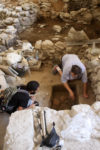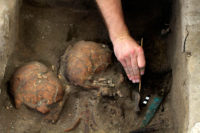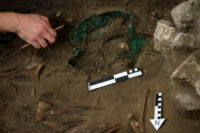 Archaeologists have discovered the graves of Canaanite warriors from the 19th century B.C. in Sidon, Lebanon. The tombs were unearthed by a team of British Museum researchers who have been excavating the Frères archaeological site for 21 years and have discovered 171 ancient burials over the decades. The two found this season are particularly well-preserved.
Archaeologists have discovered the graves of Canaanite warriors from the 19th century B.C. in Sidon, Lebanon. The tombs were unearthed by a team of British Museum researchers who have been excavating the Frères archaeological site for 21 years and have discovered 171 ancient burials over the decades. The two found this season are particularly well-preserved.
 The graves contained the skeletal remains of two adult males. The goods interred with them — bronze daggers and belts — identify the men as members of the warrior elite. The feet of sheep or goats were buried by the men’s feet so the animals would accompany them to the afterlife.
The graves contained the skeletal remains of two adult males. The goods interred with them — bronze daggers and belts — identify the men as members of the warrior elite. The feet of sheep or goats were buried by the men’s feet so the animals would accompany them to the afterlife.
[The head of the British Museum’s delegation Claude] Doumet-Serhal said the daggers were not used for fighting, but were significant because they showed the warriors belonged to the society’s elite: “The Canaanites did not bury in such a way unless the dead belonged to the aristocratic and elite class of the Canaanite society.”
DNA taken previously from other Canaanites graves at Frères compared to the DNA of 100 Lebanese showed 95 percent were of Canaanite descent, Doumet-Serhal said, adding, “We were never divided. We were all Canaanites, then we were Phoenicians, then the Romans came, then the Byzantines, then the Arabs.”
 This year’s dig season ends next week. The bronze artifacts found in the graves will be conserved and stored for future display in Sidon’s archaeological museum which has been under construction since 2014. The city’s 6,000 years of occupation and rich archaeological record has not been well represented until now. Almost all of the important artifacts unearthed in Sidon are in the National Museum in Beirut. The new museum will finally do the city’s history justice as a combination museum and archaeological park, with the city’s 6,000 years of archaeology visible under the ground floor and objects exhibited on the first floor.
This year’s dig season ends next week. The bronze artifacts found in the graves will be conserved and stored for future display in Sidon’s archaeological museum which has been under construction since 2014. The city’s 6,000 years of occupation and rich archaeological record has not been well represented until now. Almost all of the important artifacts unearthed in Sidon are in the National Museum in Beirut. The new museum will finally do the city’s history justice as a combination museum and archaeological park, with the city’s 6,000 years of archaeology visible under the ground floor and objects exhibited on the first floor.
“The belt and the daggers excavated will be placed in this Sidon museum next to all the pieces and artifacts discovered in this site over the course of 21 years,” Doumet-Serhal said.
‘ROMANES EUNT DOMUS’ 😉 – So to speak ‘all of a sudden’ Roman agressors were seen ‘ante portas’?!? –Hyksos from Canaan (‘heqa khasut’) appeared in Egypt in the 12th Dynasty and established an independent realm in the eastern Nile Delta, until they were expelled from Egypt.
Khnumhotep II (20th century BCE), for example, is well known for his tomb at Beni Hasan (‘Tomb3’), where the famous Aamu group is depicted, Asiatic nomadic traders, sometimes considered as Hyksos, or at least their forerunners; the group, led by a man called Absha.
There were independent city states, the ‘shepherd kings’ -Semitic speaking cattle nomads- and traders, who were referred to in Greece and Crete as Phoenicians. Also, there were Akkadians, Assyrians and Persians, who in return -much later- temporarily even reigned in Egypt.
In his first regnal year, Seti I. (or ‘Sethos I’) led his armies along the ‘Horus Military road’, the coastal road from the Egyptian city of Tjaru in the northeast corner of the Nile Delta along the northern coast of the Sinai peninsula ending in the town of ‘Canaan’ in the modern Gaza strip.
:hattip:
—————–
PS: At a given point in time, possibly in between all this, the little girl ‘Europe’ was trafficked away to what is known today as Crete.
I thought the Hyksos were from the region around Ninevah. They have been listed that way in British annals.
The Hyskos, Amorites, and Hittites were all Canaanite leagues of city States that ruled collectively an area from Lower Egypt to the Persian Gulf to the Agean Sea.